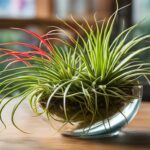Welcome to the Totem Pole Care Plant Guide, your go-to resource for all things related to caring for your totem pole plants. Whether you have a totem pole cactus or succulent, we’ve got you covered with essential information and tips to keep your green buddies happy and thriving.
From determining the bottom of the totem pole to finding the best containers and understanding optimal lighting conditions, our guide covers all aspects of totem pole plant care. We’ll help you navigate the ins and outs of nurturing these unique plants so that you can enjoy their beauty and benefits in your home.
Determining the Bottom and Optimal Lighting
When it comes to taking care of your totem pole plants, correctly identifying the bottom and top ends is crucial. The red end usually represents the bottom, while the green end is considered the top. To ensure proper care, it’s important to remove the wax from the red end using a dull butter knife, while leaving the wax on the green end intact.
Proper lighting is also essential for the health and growth of your totem pole plants. These unique plants thrive in partial sun to partial shade conditions. Placing them in an area where they receive indirect sunlight for a few hours each day is ideal. If you notice your plant reaching and leaning towards a light source, it’s a sign that it may need more light.
“To determine the bottom of the totem pole, look for the red end. The top of the totem pole is usually the green end.”
If you’re growing indoor totem pole plants, you can supplement natural light with artificial grow lights. LED grow lights are a popular choice as they provide the necessary light spectrum for optimal growth without emitting excessive heat. Remember to position the lights above the plants and maintain a consistent distance to avoid burning the foliage.
| Lighting Conditions | Recommended | Not Recommended |
|---|---|---|
| Indirect sunlight | Direct sunlight | |
| LED grow lights | Fluorescent lights |
By understanding how to determine the bottom and top ends of your totem pole plants and providing them with the right lighting conditions, you’ll be on your way to creating a thriving environment for these unique and visually striking plants.
Choosing the Best Containers and Transplanting
Choosing the right containers for your totem pole plants is essential to their growth and overall health. Clear glass containers are highly recommended during the water stage of totem pole plant care. These containers allow for better photosynthesis and provide a visually appealing display of your plants. Ensure that the container you choose can accommodate the girth of the log to provide ample space for the plant to grow.
When it comes to transplanting your totem pole plants, it is important to do it with care to avoid any damage. Transplanting should be done during the soil stage of the plant’s growth. Gently remove the plant from its current container and prepare the new container by filling it with a well-draining potting mix. Place the plant in the new container and fill any gaps with additional potting mix. Be mindful not to damage the roots during the process.
Transplanting Tips:
- Transplant during the soil stage of growth.
- Handle the plant with care to avoid damaging the roots.
- Choose a well-draining potting mix for the new container.
- Fill any gaps with additional potting mix to provide stability.
Transplanting your totem pole plants allows them to continue growing and thriving in a fresh environment. It is a crucial step in their care routine and should be done with precision and attention to detail.

| Container Type | Advantages | Disadvantages |
|---|---|---|
| Terra Cotta Pots | – Provides breathability for the roots – Absorbs excess moisture |
– Can be heavy – May require more frequent watering |
| Plastic Pots | – Lightweight and easy to move – Retains moisture well |
– May not allow for proper root aeration – Can become brittle with extended exposure to sunlight |
| Ceramic Pots | – Offers aesthetic appeal – Provides insulation for the roots |
– Can be heavy and difficult to move – May retain excess moisture |
The Symbolism of the Good Luck Totem Pole Plant
The Good Luck Totem Pole Plant holds significant symbolism in Oriental culture, representing longevity, wealth, and prosperity, particularly in the practice of Feng Shui. This plant grows gradually from a giant cutting approximately 3 inches in diameter by 12 inches tall. The leaves gradually form over time, adding to the plant’s unique aesthetic.
“The Good Luck Totem Pole Plant brings positive energy and good fortune to the home,” says Feng Shui expert Lily Chen. “Its upward growth symbolizes growth and progress in all aspects of life.”
In Chinese culture, the red color of the bottom end signifies good luck and protection against negative energies, while the green color of the top end represents growth and vitality. This combination of colors reinforces the plant’s symbolism and makes it a popular choice for those seeking positive energy in their living spaces.
According to Feng Shui principles, placing the Good Luck Totem Pole Plant in the southeast corner of a room or near the entrance brings wealth and abundance into the home. It is believed to attract good fortune and promote harmonious energy flow throughout the space.
The Symbolism of Colors in the Good Luck Totem Pole Plant
| Color | Symbolism |
|---|---|
| Red | Good luck, protection |
| Green | Growth, vitality |
Adding a Good Luck Totem Pole Plant to your home or office not only brings aesthetic appeal but also infuses positive energy and auspiciousness into your environment. It serves as a reminder to embrace growth and prosperity, while also creating an inviting and harmonious space.
Tips for Success in Totem Pole Plant Care
If you want your totem pole plants to thrive, it’s important to provide them with the right care. Follow these tips to ensure their success:
- Partial sun to partial shade: Totem pole plants thrive in these light conditions. Place them in an area where they can receive a few hours of direct sunlight each day, but also have some shade to protect them from intense heat.
- Proper watering: Water your totem pole plants when the top inch of soil feels dry to the touch. During warmer months, this may mean watering them once or twice a week. In cooler months, you can reduce watering frequency to once every 10-14 days. Avoid overwatering, as it can lead to root rot.
- Well-draining potting mix: Use a potting mix that provides good drainage for your totem pole plants. This will help prevent waterlogged soil and promote healthy root growth.
- Balanced fertilizer: Feed your totem pole plants with a balanced fertilizer once a month during the growing season. This will provide them with the essential nutrients they need to thrive.
By following these tips, you’ll be well on your way to successfully caring for your totem pole plants and enjoying their unique beauty in your home.
Common Mistakes to Avoid
- Overwatering: As mentioned earlier, overwatering can be detrimental to totem pole plants. It’s better to underwater than overwater, so make sure to let the soil dry out between waterings.
- Insufficient light: While totem pole plants prefer partial sun to partial shade, it’s important to provide them with enough light. If they don’t receive adequate light, they may become elongated and leggy.
- Using the wrong potting mix: Using a heavy, water-retentive potting mix can lead to root rot. Make sure to choose a well-draining mix specifically formulated for cacti and succulents.
- Neglecting fertilization: Totem pole plants benefit from regular fertilization, especially during the growing season. Neglecting to fertilize them can result in nutrient deficiencies and slow growth.
When caring for totem pole plants, it’s essential to avoid these common mistakes to ensure their health and vitality.
Moss Poles for Climbing Plants
Climbing plants, such as totem poles, rely on sturdy vertical support to grow upward and thrive. Moss poles are an excellent tool for providing this essential support while also providing additional moisture and nutrients to the plants. Made from organic materials like coconut fiber or sphagnum moss, moss poles create a natural environment for climbing plants to flourish.
Moss poles come in different sizes to accommodate the growth of various climbing plants. Whether you have a small totem pole cactus or a larger succulent, there is a moss pole suitable for your plant’s needs. These poles not only facilitate upward growth but also enhance the aesthetic appeal of your indoor garden.

Benefits of Moss Poles:
Moss poles provide several benefits to climbing plants:
- Sturdy support: Moss poles offer a stable structure for climbing plants, preventing them from leaning or toppling over.
- Encourages natural growth: By mimicking the plants’ natural climbing behavior, moss poles encourage healthy and upward growth.
- Moisture retention: The organic materials in moss poles retain moisture, providing a consistent water supply to the plants.
- Nutrient-rich environment: Moss poles release essential nutrients as they break down, benefiting the plants’ overall health and growth.
Moss poles are easy to set up and use. Simply insert the pole into the potting soil, ensuring it is stable. Gently wrap the plant’s vines around the pole, encouraging them to climb upward. If needed, use plant ties or clips to secure the vines to the pole. Regularly check on the plant’s growth and guide it around the pole to ensure successful climbing.
Comparison of Moss Poles:
To help you choose the right moss pole for your climbing plants, here is a comparison of different types:
| Type | Material | Size | Features |
|---|---|---|---|
| Natural Coconut Fiber Pole | Coconut fiber | Various lengths | Provides excellent moisture retention and stability |
| Sphagnum Moss Pole | Sphagnum moss | Various lengths | Offers superior water absorption and nutrient release |
| Coir-Wrapped Moss Pole | Coconut fiber and sphagnum moss | Various lengths | Combines moisture retention and sturdy support |
Choose the moss pole that best suits your plant’s needs and the aesthetics of your indoor space. With the right support, your climbing plants will thrive and add a touch of natural beauty to your home.
How to Set Up and Train Plants on Moss Poles
Setting up a moss pole for your climbing plants is a straightforward process that can greatly enhance the growth and health of your plants. To begin, choose a moss pole that is the appropriate size for your plant’s growth potential. Insert the pole into the potting soil, making sure it is stable and securely anchored. This will provide the necessary support for your plants as they grow.
Once the moss pole is in place, gently guide your plant’s vines around the pole. This will encourage upward growth and give your plant the structure it needs to climb. If necessary, use plant ties or clips to secure the vines to the pole, ensuring they stay in place. This will help the plant establish itself and properly attach to the pole as it continues to grow.
Regularly check on your plant and guide its growth around the moss pole as needed. As the plant grows, it may require additional support or direction to continue climbing. By gently guiding the plant and ensuring it stays on the moss pole, you will help promote healthy growth and prevent the plant from sprawling or becoming tangled.
Remember to be patient with your plant as it adjusts to its new support system. Over time, it will become accustomed to the moss pole and begin to thrive. With proper care and attention, your climbing plants will grow and flourish, creating a stunning display in your home or garden.

Benefits of Using Moss Poles for Climbing Plants
Using moss poles for climbing plants offers several benefits. Firstly, they provide sturdy vertical support, allowing plants to grow upward and mimic their natural climbing behavior. Moss poles also provide additional moisture and nutrients to the plants. The organic materials, such as coconut fiber or sphagnum moss, used in moss poles help retain moisture and create a favorable environment for the plants to thrive.
Furthermore, moss poles can be a decorative addition to your indoor or outdoor space. They add a touch of natural beauty and create an eye-catching feature. Additionally, moss poles can help manage the growth of climbing plants. By providing a designated area for the plants to grow, they prevent the plants from spreading and taking over other areas of your garden or living space.
In summary, setting up and training plants on moss poles is a simple yet effective way to support the growth of your climbing plants. By providing stability and structure, moss poles help your plants grow upward and thrive. With the added benefits of moisture retention and decorative appeal, moss poles are a valuable tool in your gardening arsenal.
Conclusion
Taking care of your totem pole plants is essential to their health and well-being. By following the guidelines provided in this plant care guide, you can ensure that your totem pole plants thrive and flourish in your home.
Remember to determine the bottom and top ends of your totem pole plants, and scrape off the wax from the red end while leaving it intact on the green end. Choose the best containers for your plants, using clear glass containers during the water stage to allow for optimal photosynthesis.
Additionally, consider using moss poles to support the growth of your climbing plants. These poles provide vertical support and extra moisture and nutrients for the plants. Set up the moss pole by inserting it securely into the potting soil and gently wrap the plant’s vines around it to encourage upward growth.
Finally, give your totem pole plants regular care, including proper watering, fertilizing, and grooming. Ensure that they receive partial sun to partial shade and use a well-draining potting mix. With these tips and knowledge, your totem pole plants will thrive and bring beauty to your home.
FAQ
How do I determine the bottom and top ends of my totem pole plant?
The bottom end is usually the red end, while the top end is the green end. You can scrape off the wax from the red end using a dull butter knife, but leave the wax on the green end intact.
What type of container should I use for my totem pole plant?
It is recommended to use a clear glass container that can accommodate the girth of the log. Clear glass allows for more photosynthesis.
How often should I change the water for my totem pole plant?
It is best to change the water for your totem pole plant 1-2 times a week, adding only 3 inches of water each time.
What does the Good Luck Totem Pole Plant symbolize?
The Good Luck Totem Pole Plant represents longevity, wealth, and prosperity in Oriental culture, particularly in the practice of Feng Shui.
What lighting conditions do totem pole plants thrive in?
Totem pole plants thrive in partial sun to partial shade.
How often should I water my totem pole plants?
Water your totem pole plants when the top inch of soil is dry, about once or twice a week during the warm months and less frequently in cooler months.
What type of potting mix should I use for my totem pole plants?
Use a well-draining potting mix for your totem pole plants.
What are moss poles used for?
Moss poles are used to provide sturdy vertical support for climbing plants, including totem poles.
How do I set up a moss pole for my climbing plants?
Insert the moss pole into the potting soil, wrap the plant’s vines around the pole to encourage upward growth, and secure the vines to the pole if needed.
How should I care for my totem pole plants?
Provide proper watering, fertilizing, and grooming to ensure the health and well-being of your totem pole plants.





